Class 15. England in the 19th century. Victorian Age
French Revolutionary and Napoleonic Wars
French Revolutionary (1792-1802) and Napoleonic (1803-1815) Wars were a series of international conflicts that involved all European powers and their colonies. The French Revolutionary Wars started as a consequence of the Great French Revolution, when neighbouring states invaded France in a hope to defeat it while it was allegedly weak due to the revolutionary struggle. The French Republic was able to defeat its enemies, partly due to military talents of Napoleon Bonapart, one of the leaders of the French Army.
The Napoleonic wars (Napoleon would be proclaimed Emperor of France in 1804) were driven by the Napoleon's desire to unite Europe under the French dominance. Having defeated most of European powers (including Russia), until his ill-fated Russian campaign of 1812, Napoleon saw no other threat to his plans for the European dominance, apart from the British command of the seas. Actually, it was the confrontation between France and Great Britain which lasted throughout the whole period of the French Revolutionary and Napoleonic Wars, ending only in 1815, with the final defeat of the Napoleon's forces and hopes.
The Battle of Trafalgar (1805)
When another war between Great Britain and France burst out in 1803, Britain imposed a naval blockade which had a devastating effect on the French trade and economy. In response, Napoleon started to elaborate plans to invade Britain and submit it to his power. The naval superiority of the Royal Navy was the main obstacle in these plans; in an effort to destroy this dominance, the French and the Spanish combined their navies . On 21 October 1805, the Battle of Trafalgar was fought fought between the British Royal Navy and the combined fleets of the French Navy and Spanish Navy, ending with a decisive British naval victory. The British victory spectacularly confirmed the naval supremacy that Britain had established during the past century and which would not be challenged until the First World War (1914-1918).
Admiral Lord Horatio Nelson
English naval officer famous for his service in the Royal Navy. He won several victories, including the Battle of Trafalgar in 1805, during which he was killed. Nelson is considered as one of the best naval commanders ever, the greatest British naval commander of all times and No. 9 in the BBC 2002 list The 100 Great Britons. Nelson was killed during the Battle of Trafalgar, which added to his image of the war hero.
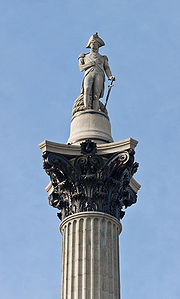
Nelson's Column in Trafalgar Square, London; the most famous memorial to Nelson
The Battle of Waterloo
The 1812 invasion of Russia was a military disaster for Napoleon, and by 1814, a coalition of his enemies headed by England, Russia, Prussia and Austria entered Paris, and Napoleon was imprisoned on the island of Elba. However, on 1 March 1815, Napoleon landed in France again with a hope to restore his imperial power and re-impose French dominance over Europe. His short rule, known as the Hundred Days, ended with the Battle of Waterloo (18 June 1815), in which the combined Anglo-Dutch force under Duke of Wellington held back the Napoleon's superior force and later was able to defeat the French with the help of arriving Prussian reinforcements. The Battle of Waterloo became a major involvement of the British Army on the European continent during the nineteenth century and one of the most famous battles in the history of humanity.
Following his defeat at the Battle of Waterloo, Napoleon was sent to exile to the island of Saint Helena, where he died in 1821.
Arthur Wellesley, 1st Duke of Wellington was one of the leading English military and political figures of the nineteenth century. He is mostly remembered for his command of the Anglo-Allied forces at the Battle of Waterloo. In the above-mentioned BBC list The Hunred Great Britons, Arthur Wellesley is ranked 15th. The capital of New Zealand is named after him.
Victorian Britain
Queen Victoria ruled the United Kingdom from 1837 to 1901. It was the heyday of the British Empire, which grew immensely, controlled most of the world trade and was the first-ever superpower in the history of humanity. British dominance would start to wane in the early 20th century, particularly after the First World War, which would add to the image of the Golden Age of Queen Victoria.

Queen Victoria in 1887
The Victorian Era was the age of rationalism and positivism. It was the time of great technological and scientific breakthroughs, when people believed in the progress of the human civilisation.
In foreign politics, Britain managed to build the largest empire in the human history. In domestic politics, it was the era of political liberalism and gradual reforms, which would later prevent major social turmoils, like the Russian or German revolutions.
Famous landmarks of the Victorian Era
Steamships
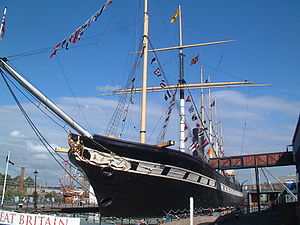
Steamships like SS Great Britain (above, launched in 1843) greatly accelerated international trade and travel.
Steamships would become the object of the first arms race, which started between the United Kingdom and the German Empire in 1898, at the dawn of the Victorian era.
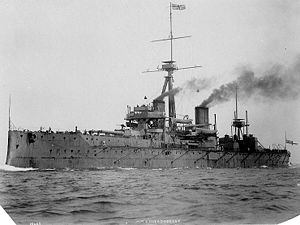
HMS Dreadnought (1906), the symbol of the naval arms race between Britain and Germany.
Railways

In 1830, the first-ever intercity railway was built between Liverpool and Manchester. Railways became the symbol of the Victorian England, greatly facilitating land transportation.
In the late 19th century, the British Empire was involved into one of the most ambitious projects in the history of the railway construction: the Cape to Cairo Railroad which was to cross Africa from south to north. Although the project was uncompleted due to a number of economic and political obstacles (and it remains complete until now), it demonstrates the scale of British imperial ambitions.

Photography
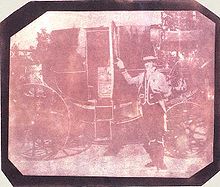
During the Victorian Era, photography became a part of the everyday life. Depicted above is one of the first photos made, a picture of a coachman made in 1840.
London Underground
Roughly between 1825 and 1925, London was the largest city in the world. It created a huge number of problems, including transporation, as its narrow medieval streets were poorly suited for the greatly increased traffic. In 1854, the Parliament allowed the construction of the underground railway and in 1863, when the first section was opened, it became the first underground railway system in the world.

The London Underground currently remains the longest (in terms of route length) metro system in the world.
Thames Tunnel
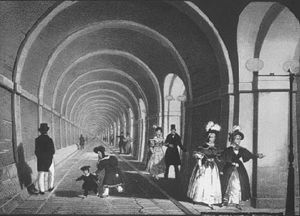
Built between 1825 and 1843, the tunnel under the Thames was one of the engineering wonders of the nineteenth century.
London sewerage system
Although not a very elevated phenomenon, London sewerage system built between 1859 and 1865 was the first modern system for the disposal of sewage and served as an example for other systems of this kind.
Telegraph

In 1839, the first commercial electric telegraph line was built in Great Britain, marking the beginning of the era of fast communications. By the late 19th century, telegraph lines would link all continents except Antarctica.
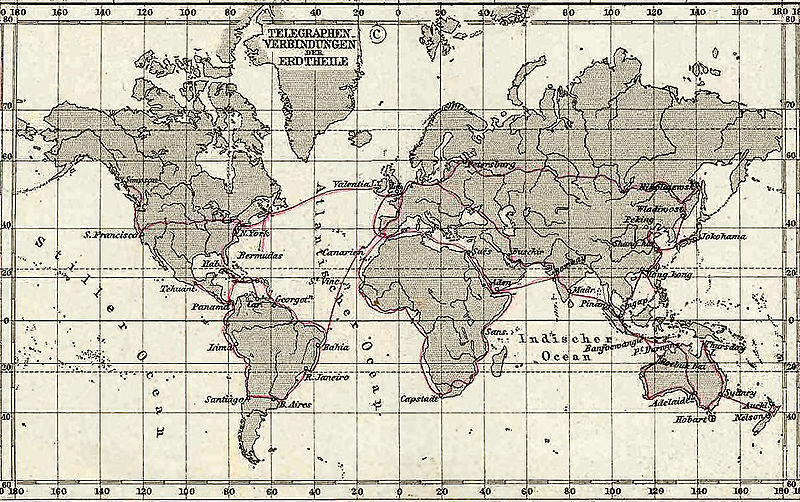
Telephone

Although an American invention, telephone (invented in 1876 and introduced in London in 1878) became a feature of the British life during the Victorian Era. However, the famous red telephone box (below) was introduced only in 1924.

Automobile
Also invented outside Britain - automobile was invented by Karl Benz, a German engineer, in 1885 - the British automobile industry would claim international recognition. The first UK-produced car (below) was made in 1896.
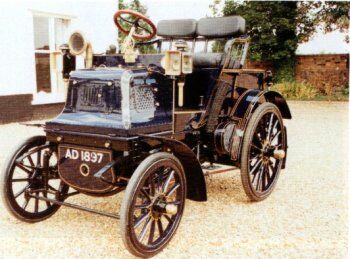
Cinema
This time a French invention, cinema also became one of the symbols of technological progress of the Victorian Era. The earlies surviving motion picture originates from Britain and can be seen here.
The Crystal Palace
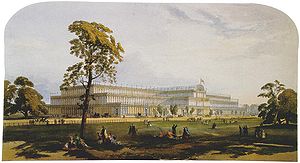
In 1851, the Great Exhibition of the Works of Industry of all Continents was to be held in London - the first major industrial world exhibition. For this purpose, a special building was erected which was to reflect Britain's superiority in modern technologies. It was made of steel and glass - and nothing more, becoming one of the most remembered symbols of the Victorian England. The building was destroyed by fire in 1936.
The picture below shows Queen Victoria opening the Great Exhibition in the main hall of the Crystal Palace.
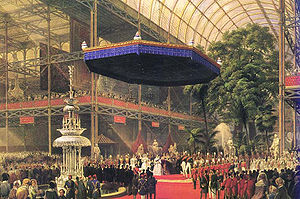
Urban landscape
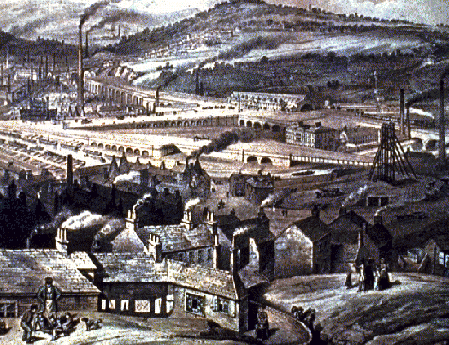
The Industrial Revolution brought to life an industrial landscape (or, rather, industrial cityscape). Some British towns (like Manchester, depicted below) transformed into huge factory metropolisises.
